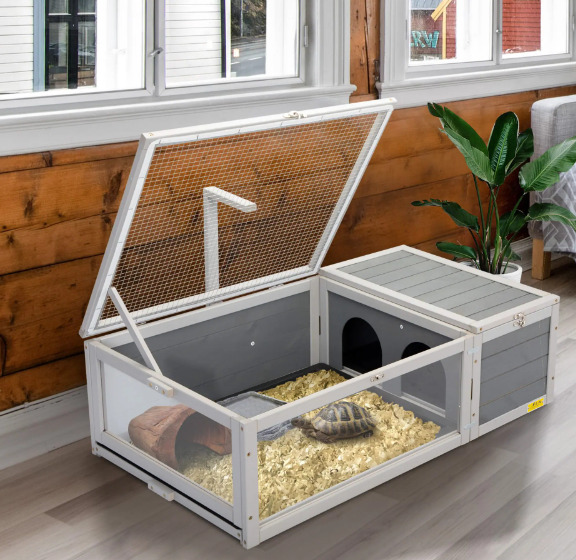Turtles make fascinating and delightful aquatic pets, and providing them with a suitable environment is crucial for their well-being. Setting up a turtle tank requires careful consideration of various factors to ensure a safe and comfortable turtle habitat. In this guide, we’ll take you through the step-by-step process of creating the perfect turtle tank setup, from selecting the right tank to maintaining optimal water conditions.
Essential Turtle Habitat Elements
Choosing the Right Tank
Selecting the appropriate tank is the foundation of a successful turtle habitat. The tank’s size largely depends on the species and size of your turtle. As a general rule, aim for at least 10 gallons of water per inch of your turtle’s shell length. Bigger is usually better, as turtles need ample space to swim, explore, and bask.
Setting Up Filtration and Heating Systems
Turtles are messy creatures, and proper filtration is essential to maintain clean water. A reliable filter system, such as a canister or submersible filter, helps remove waste, excess food, and toxins. Additionally, turtles are ectothermic, meaning they rely on external sources for temperature regulation. Install a water heater and basking lamp in the habitat of a turtle to maintain the appropriate water and basking area temperatures based on your turtle’s species requirements.
Providing UVB Lighting
UVB lighting is essential for your turtle’s health, as it enables them to metabolize calcium and prevent metabolic bone disease. Install a UVB lamp above the basking area in the habitat of a turtle, ensuring that it’s the appropriate strength for your turtle’s species. Replace the bulb as recommended by the manufacturer to maintain its effectiveness.

Health and Maintenance of Turtle Habitat
Water Quality and Maintenance
Maintaining water quality of turtle habitat is a top priority. Use a water testing kit to monitor parameters such as ammonia, nitrite, nitrate, and pH levels. Perform partial water changes (around 25-30% of the water) weekly to keep water conditions pristine. Regularly clean the filter to ensure it functions optimally, removing debris that could compromise water quality.
Monitoring and Adjusting
Setting up a turtle habitat is not a one-time task; it requires ongoing monitoring and adjustments. Regularly check water parameters, water temperature, and UVB light output. Be prepared to make changes based on your observations and any changes in your turtle’s behavior or health.
Species-Specific Care in Turtle Habitat
Handling and Interaction
While turtles can be fascinating to observe, they generally do not enjoy being handled extensively. Frequent handling can cause stress and discomfort for them. Instead, focus on creating an engaging habitat of a turtle within the tank that offers them opportunities for mental and physical stimulation.
Quarantine Procedures
Before introducing a new turtle to your turtle habitat, it’s crucial to follow proper quarantine procedures. Quarantine helps prevent the introduction of diseases or parasites into your established tank. Keep the new turtle in a separate enclosure for several weeks while closely monitoring their health before adding them to the main tank.
Species-Specific Considerations
Different turtle species have unique requirements based on their natural turtle habitat and behaviors. Some turtles are more aquatic, while others are semi-aquatic or prefer drier environments. Research your turtle’s species thoroughly to ensure you’re meeting their specific needs for water depth, basking area, diet, and more.
Feeding and Nutrition
Offering a balanced and varied diet into turtle habitats is essential for your turtle’s health. Different turtle species have distinct dietary preferences, which may include aquatic plants, commercial turtle pellets, live or frozen prey, and occasional fruits. Research your turtle’s specific nutritional requirements and adjust their diet accordingly.

Continuous Learning and Responsible Ownership
Responsible Ownership and Education
Being a responsible turtle owner involves continuous learning and adapting your care practices as new information becomes available. Stay updated on the latest advancements in turtle care and turtle habitats, and consider joining online forums or local reptile clubs to connect with experienced turtle keepers and share insights.
Regular Health Checkups
Regular veterinary checkups are crucial to ensure your turtle’s well-being. Find a veterinarian experienced in treating reptiles to perform routine health assessments and address any concerns promptly. Maintaining good water quality, a balanced diet, and appropriate temperatures in the habitat of a turtle greatly contributes to your turtle’s overall health.
Handling and Taming Techniques
While minimal handling is recommended, occasional interactions can help tame your turtle and reduce stress during essential tasks such as health checkups and tank maintenance. Gently offer treats into turtle habitat while interacting to associate positive experiences with your presence. Always handle your turtle with clean hands and avoid sudden movements that could startle them.
Tank Enrichment and Mental Stimulation
To prevent boredom and promote mental stimulation, introduce tank enrichment. Offer toys, floating objects, and objects they can push around to engage their natural curiosity. Rearrange decorations periodically to provide a new turtle habitat for exploration, encouraging your turtle to remain active and engaged.
Creating an ideal turtle tank setup is a rewarding endeavor that requires careful planning, research, and dedication. By providing your turtle with a well-designed and comfortable turtle habitat that meets their physical, mental, and social needs, you’re ensuring their overall well-being and longevity. The combination of proper filtration, heating, lighting, substrate, and enrichment creates a harmonious environment where your turtle can thrive. As you embark on this journey of turtle ownership, remember that the time and effort you invest in setting up a suitable habitat will be reflected in the health, happiness, and vibrant personality of your aquatic companion.
